ILLUSTRATING SOME OF THE UNIVERSITY MEDALS OF JAMES ROLAND RIDER
 James Roland Rider was the son of a veterinary surgeon. He was born in Beamish, near Durham, in N.E.England, on 13 November 1894. He was educated at St. Bees, Cumbria, and at Newcastle Royal Grammar School.
James Roland Rider was the son of a veterinary surgeon. He was born in Beamish, near Durham, in N.E.England, on 13 November 1894. He was educated at St. Bees, Cumbria, and at Newcastle Royal Grammar School.
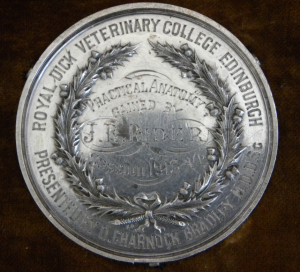
Reverse of silver medal, Session 1913-1914, Royal (Dick) Veterinary College, Edinburgh, Presented by O. Charnock Bradley M.D., D.Sc., Practical Anatomy, Gained by J.R.Rider
In 1912 he went to Edinburgh to study at the Royal (Dick) Veterinary College but in 1914 the outbreak of war interrupted his studies. Rider enlisted in the Scots Greys and he served at Gallipoli.
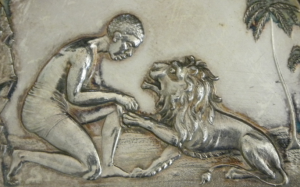
Detail from obverse, silver medal, Session 1913-1914, decorated with lion with raised paw being treated by kneeling figure, framed by palm trees and cliff

In 1916 he returned to the Dick Vet’, and the University medal-winning Rider graduated in 1917, becoming a Member of the Royal College of Veterinary Surgeons. He then re-enlisted, serving as a Captain in the Army Veterinary Corps (AVC).
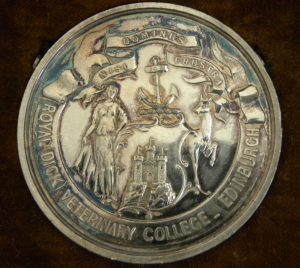
Obverse, silver medal, Obstetrics, Session 1917-18, Royal Dick Veterinary College, Edinburgh, decorated with armorial bearing of the City of Edinburgh and inscription NISI DOMINUS FRUSTRA
The AVC was responsible for the medical care of animals used by the army; predominantly horses, mules and pigeons. During the Great War, the Corps reorganised to provide a Mobile Veterinary Section as part of each Division that went overseas. A number of Base Veterinary Hospitals were established in the theatres of war. Most animals suffered from battle injuries, debility, exhaustion, mange and, for the first time, gas attacks.
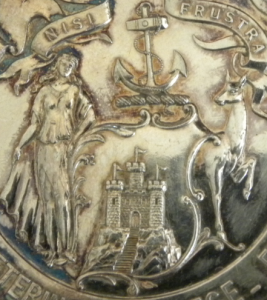
Detail from silver medal, Obstetrics, Session 1917-18
By 1918 almost half of the veterinary surgeons in Great Britain were serving in the AVC. As an Army veterinary surgeon, Rider served until the end of the War and was awarded a pair of medals – the British War medal, and the Victory medal.
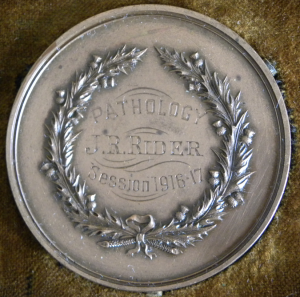
Reverse, bronze medal, decorated with thistle wreath surrounding the inscriptions – Pathology. J.R.Rider, Session 1916-17
On 27 November 1918 King George V conferred the Royal prefix to the Corps in recognition of the work of the AVC… or RAVC (Royal Army Veterinary Corps).
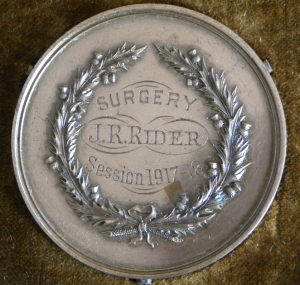
Reverse, bronze medal, decorated with thistle wreath surrounding the inscriptions – Surgery. J.R.Rider, Session 1917-18
From 1919 Rider was employed as a vet by Pease and Partners Ltd. owners of several mines in the coalfields of Durham and Teeside. In 1928 he declined the offer of a Lectureship at the Royal (Dick) Veterinary College, only to suffer a cut in working hours the following year due to the Depression which began in 1929. In 1930 however, Rider began his own private practice in Darlington.
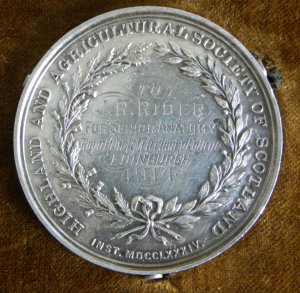
Reverse, silver medal, Highland and Agricultural Society of Scotland, To J.R.Rider, for Senior Anatomy, 1914, Royal (Dick) Veterinary College, Edinburgh, Inst. MDCCLXXXIV
In 1932 he published a paper on ‘Hypertrophy and diverticulae in the ileum in pit ponies’ for the Veterinary Record, British Veterinary Association.
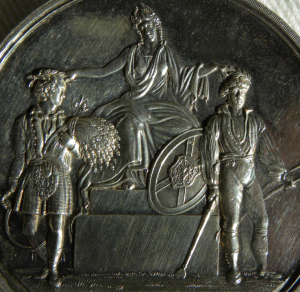
Detail, obverse, silver medal, Highland and Agricultural Society of Scotland, decorated with raised seated classical figure with Scottish armorial shield honouring figures representing agriculture and industry
James Roland Rider died of pulmonary tuberculosis in Urpeth, Durham, on 19 November 1942.
![]()
Dr. Graeme D. Eddie, Assistant Librarian Archives & Manuscripts, Centre for Research Collections
![]()
